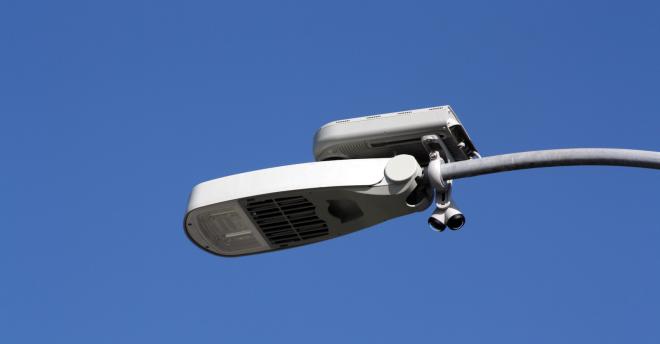
Photo: Ubicquia
How to make smart streetlighting upgrades a success
09 November 2022
Sponsored by: Ubicquia
Streetlighting upgrades offer several benefits for cities, including energy and cost savings of up to 80 percent, as well as the ability to address challenges such as public safety, the digital divide, air quality and traffic management.
In a recent report and webinar, experts shared their tips on how to make these projects successful and get the most from systems.
Streamlined approach
As cities invest in upgrading their infrastructure, a long-term view is key. Adding sensors and cameras in a piecemeal fashion creates cluttered streetscapes and adds costs.
The latest streetlight solutions, for example, are an evolution of LED upgrades and smart controllers, supporting third-party equipment including cameras and license plate readers as well as options for integrated cameras, directional microphones, and neural AI processors.

An integrated approach offers better aesthetics and also makes better sense financially because the major cost of the unit and installation is only incurred once.
Joseph Friedman, Director of Product Management at technology company Ubicquia, said: “Normally if cities want to put a camera, license plate recognition camera or sensor up, they need to get a permit, have a pole installed and run power to that pole. It’s expensive and time-consuming.
“Using plug-and-play streetlight systems enables a very quick deployment in a much more aesthetically pleasing footprint.”
Design and technical considerations
Many cities are looking at ways to better leverage assets such as streetlights and buildings to expand digital connectivity, boost safety and manage traffic.
“Number one is to identify the availability of existing infrastructure and overlay it to start looking at it as a large planning exercise so that you can determine what’s available for use,” said Ron Ivie, President, Telcon Services, LLC, a connectivity systems integrator that works with cities, private companies and utilities.

The map should include assets like fiber, streetlights and existing cameras as well as foliage and other obstacles.
Identifying the priorities, drivers and stakeholders is also key to get the right solution and architecture in place for a smart streetlighting system.
Many cities have both immediate goals and longer-term strategies – deployments can start in a small area for a fixed time but scale city-wide.
“Understand what the ultimate plan is for this,” said Ivie, adding that many cities want the flexibility to move quickly with the ability to add cameras or sensors within hours if necessary.
Organizational alignment
Because they cut across city departments and sometimes external utilities, smart streetlight projects require organizational alignment – between entities that own the streetlights as well as those that have a use case for sensor and camera data.
The projects typically bring together teams including IT, public works, innovation offices, and public safety and police departments. Ivie said some cities are beginning to set up broadband divisions or similar entities to manage assets such as streetlights.
Adding lighting controllers and smart application capabilities at the same time as carrying out LED upgrades is the most efficient process, said Friedman.
Smart tactics
Tod Riedel, Director, Video Security and Access Control, State and Local Government, Avigilon, said many cities are now bolstering their camera networks.

“The other fundamental fact is you cannot watch these cameras 24/7 so you’ve got to have some kind of intelligence and analytics to let the camera do the work for you,” he added.
The latest analytics capabilities include unusual motion and activity detection, and appearance search technology – for example, searching for a missing person by selecting certain specific physical descriptions, including hair and clothing color, and gender. This is different from facial recognition, Riedel points out.
Transparency
Some cities report residents requesting additional public safety measures, often following crime spikes or incidents. However, there have also been examples of backlashes against technology projects – especially when systems have been implemented without the opportunity for public scrutiny or have been introduced for one reason and then used for others.

“Every municipality is a little different,” said Raymond Martinez, a Managing Director at V2 Global consultancy where he specializes in public policy for law enforcement. “But the first thing that we tell everyone is that transparency with the community, making the community part of the conversation on any technology that may be deployed and its purpose, is key.
“This helps to take away any miscommunication or misconceptions. Cities are increasingly taking action to get ahead of these issues through policies, resident engagement processes, and other interventions.”
Martinez previously served as Assistant Chief of Police for Miami Police Department and Chief of Police at Miami Beach Police Department.
Other transparency measures include privacy advisory and oversight boards, policies for data-gathering technologies, and signage to provide information about systems deployed.
Finding funding
Having the right strategic alignment also strengthens the business case for technology investments – particularly to make the most of multi-purpose platforms that benefit several departments.
As well as leveraging grants from states and federal programs such as the Infrastructure Investment and Jobs Act, financing options include local bank funding, municipal bonds, public-private partnerships, and infrastructure-as-a-service models. Because of the long-term, city-wide benefits, many cities also self-fund projects using existing operations and maintenance or capital budgets.








